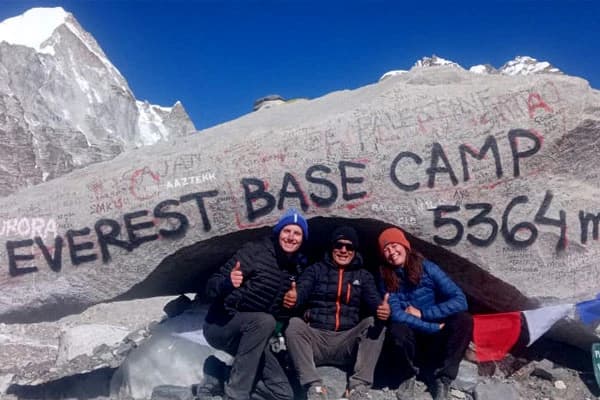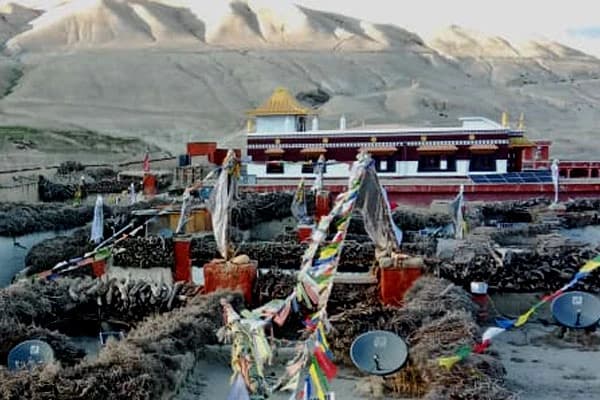About Annapurna Circuit Trek:
Among all the trekking destinations in the Annapurna Region of Nepal, the trek to Annapurna Circuit stands as the traditional and widely recognized path. Throughout the Annapurna Circuit Trekking, you explore the Annapurna Conservation Area (ACAP) by moving from the Manang to Mustang districts to view the complete Dhaulagiri and Annapurna Himalayan Range of Nepal. Thorong La Pass, together with Kali Gandaki Valley, is the primary reason why the trek is as popular as the Gokyo Lake Trek and Everest Three Passes Trek.
The Annapurna Trail Nepal begins its journey in the lower regions where its path crosses green hills with terraced farms while leading through small settlements into subtropical forested areas filled with rhododendron and oak trees. Moving up to higher altitudes reveals alpine meadows together with glacier valleys that present spectacular views of the Annapurna range.

The path leads into Manang Valley, where you pass through old monasteries and reach Gangapurna Glacier. The pathway leads down to Muktinath Temple, following the pass before entering the desert-like Mustang region. The trek ends with a sunrise hike at Poon Hill which provides clear views of 17 snowy mountain peaks.
Combined with the easyGhorepani Poon Hill Trek this adventure is one for the books. Do you not agree that the Nepal Annapurna Circuit Trek is an odyssey of a lifetime, a complete package!
What makes any trek challenging in the first place?
What is the first thing that becomes a challenge? It is a physical strain on the body as you have to walk uphill and downhill, testing your endurance.
The trails may not be easy to walk on, with steep, rocky, and uneven paths that add more load to your legs and test your endurance during long hiking days with heavy backpacks.
Unexpected weather remains a constant factor during trekking that you cannot control. Hiking long distances becomes harder in adverse weather conditions, which include extreme rain and snow combined with high levels of humidity.
And how can we forget the altitude? Trekking at high altitudes means the air is getting thinner and colder, and your lungs put extra effort into breathing. Headache and shortness of breath may cause you discomfort and if you do not take care of it on time, it can even lead to altitude sickness. Be alert! Watch out for the early signs.
Being far from home in the remote and unknown territory may test your mental endurance as there are basic lodging facilities and meals. If you expect luxury in the Annapurna Circuit Trekking, you will find it challenging. So keep a positive mindset!
Factors Influencing the Annapurna Circuit Trek Difficulty
Multiple significant elements determine the difficulty of this trek to Annapurna Circuit and most of these determining factors are not under our direct control. Understanding these factors like distance, durations, age, experience level and weather, you can plan ahead for a smooth success. Simply, Annapurna Circuit Trek falls under a moderately difficult trek that depends on several factors, and this blog breaks down a detailed overview of what makes this odyssey challenging yet simply rewarding.

Now, let's break down the major factors in detail so you can understand exactly what and how they make your Annapurna Hike challenging.
Distance and Duration
Most Annapurna Circuit Trek in Nepal routes extend between 160 to 230 kilometers, which translates into 100 to 145 miles according to different route combinations and planned schedules. The complete Annapurna Circuit trekking route lasts between 12 to 21 days while demanding daily walking of 6-8 hours as you traverse 10 to 13 kilometers each day, which is easier than the Kanchenjunga Circuit Trek and Manaslu Circuit Trek. A person who has no experience walking long distances in mountainous areas will likely struggle to keep up the pace. So, just try to engage in some sort of physical strengthening activities such as hiking, running, walking or just meandering around parks completing 10,000 steps, however, it is highly suggested to be prepared to take Annapurna Circuit Trek challenges.
Here are some Annapurna Circuit Trek packages depending on duration:
Terrain
The Annapurna Circuit offers many different types of walking terrain as initially the terrain consists of rural villages combined with green fields that guide travelers along dirt roads. You will find these lower sections accessible for walking without much difficulty so it won't be a problem.
Moving toward higher altitudes makes the path surfaces steeper with challenging rocky terrain. Multiple sections of the path include stone steps that lead you up and down the steep terrain.
The landscape of Thorong La Pass which is the highest point of the Annapurna Trek in Nepal, shows rocky terrain that contains loose stones. The terrain includes areas covered with ice or snow that create dangerous slippery conditions.
The route consists of narrow paths that present steep edges on one side and small wooden bridges help you cross the rivers. You need to keep a good balance to avoid accidents.
Altitude
Any person engaging in high-altitude trekking runs a risk of developing AMS (Acute Mountain Sickness), which is commonly called altitude sickness, regardless of their climbing experience. The elevation of Thorong La reaches 5416 meters to become the highest altitude point throughout the Annapurna circuit Trek Route where altitude sickness remains a continuous threat.
All standard Annapurna Circuit Trek itineraries include controlled elevation rises that enable your body to adapt properly. Watch for mild symptoms, including headaches, nausea, and dizziness, that may arise,e and if they are not treated in time, you can suffer from severe altitude sickness.
Weather and Temperature
The trekking experience and the challenges along the Annapurna Circuit depend on weather conditions, which can be unpredictable. Spring months between March and May, along with autumn seasons between September and November, display suitable climatic conditions for viewing mountains in the Annapurna Region with temperature ranges from 10 to 20°C and 5 to 15°C. A climate with moderate temperatures allows you to walk extended days without experiencing sweating.
During winter months (Dec- Feb) extreme weather creates extremely cold conditions (-5 to 10°C) and heavy snow, which makes trekking more difficult in higher elevation areas. The Thorong La Pass may be blocked with thick snow and icy trails. Temperatures range from 15-25°C in the monsoon, while rainfall is frequent, causing slippery conditions and occasional landslides that block the trail.
Acclimatization
If you ask any expert hiker about the essential factor in high altitude treks, acclimatization is surely among the answers. Since the Annapurna Trail in Nepal takes you to the highest mountain pass, Thorong La Pass, which is over 5000 meters, your body may find it difficult to handle the high elevation gain. Acclimatization helps your body adapt to thin air and high altitudes so you won't face the problem of altitude sickness. As experts say, listen to your body and take it slow!
How difficult is it to trek to the Annapurna Circuit?
Now, after considering all the factors, how difficult is the Annapurna Circuit Trek?
To simply answer that, the Annapurna Circuit Trek exists within Nepal's easy-to-modernly challenging treks that an expert trekker can easily complete. Although beginner hikers may need some assistance and planning, they can do it successfully as it requires about 5-8 hours of walking every day, covering 10-13 km.
The Annapurna Circuit Trail features two portions, including a gentle path and a challenging ascent route. The trail from Dharapani to Manang remains easy to walk through until the elevation of Yak Kharka reaches 4030 meters where rugged and steep land extends to Muktinath.
The world's highest Thorong La Pass at 5416 meters demands special attention because the pass trails become extremely icy and dangerous to navigate.
But do not jump to conclusions yet! You can complete the Annapurna Circuit Trekking journey without much challenge with proper preparations.
Is it possible to do the Annapurna Circuit Trek solo?
Are you the type of person who enjoys both solo travel and peaceful interactions with nature? If yes, here is some good news because you can do the Annapurna Hike on your own. Every year, many solo trekkers have successfully done this trek with proper preparations. The marked path enables easy route navigation through most sections. Many different teahouses exist throughout the trail that offer essentials, including accommodation services.
You need to prepare yourself for specific challenges when planning solo trekking in the Annapurna Region. When you travel alone, you must deal with emergencies all by yourself in remote locations. Your experience will remain incomplete when you miss out on local guide explanations about the nature and culture of the area.
You should consider solo travel if you possess expert abilities and enough solo trekking experience. New trekkers should team up with local trekking agencies for a licensed guide and logistics services.
Is the Annapurna Circuit Trekking dangerous?
Thousands of travelers have safely finished the Annapurna Trek in Nepal because it presents no dangerous challenges. It presents a lower level of difficulty when compared with the distant treks such as the Upper Dolpo Trek and the Manaslu Round Trek. The trails are mostly easy to navigate with enough teahouses for rest and food. The most challenging part can be the Thorong La Pass crossing, especially in winter with icy trails and thick snow, but steady and careful stepping keeps you safe.
A local guide provides the best emergency assistance and route navigation since they know the trails most effectively.
Can beginners trek to the Annapurna Circuit?
With sufficient preparation, beginners can complete the Annapurna Circuit Trek, although it offers a moderate level of difficulty. Beginners must give extra attention to preparation and plan the trek in the spring or autumn season for fewer challenges. Many teahouses along the route make logistics easier, and walking at a slow pace with enough breaks is helpful. First-time travelers should consider hiring a guide because it ensures their safety. The Short Langtang Valley Trek (4-5 days) makes an excellent first step that leads to attempting the entire circuit for a beginner. Motivated beginners who prepare properly can be successful in completing the Annapurna Region Trek with good fitness levels.
At what age range is the Annapurna Circuit Trek most suitable?
Any age group ranging from age 12 through 60+ with average fitness levels can complete the Annapurna Circuit Trek Nepal. Yes, you heard it right! Proper pacing and supervision allow children starting at age 12 to manage the trek, while active and fit seniors can also do it. Before starting their trek, seniors must receive medical advice concerning potential altitude-related health issues.

As the saying goes, "Age is just a number", you need good physical fitness and stamina no matter what your age is. A guide or porter will be your best buddy throughout the Annapurna Trekking journey to ensure your safety.
Can I do the Annapurna Circuit Trek without a guide?
Everyone should consider hiring a guide for the Annapurna Circuit trek, even though it is not compulsory as he has deep knowledge about mountain paths, so there is no chance of getting lost. The guide maintains fluency in English and Nepali, which allows him to speak with local people when you need assistance or information.
Having a guide will enhance your journey because he will share knowledge about both the natural and cultural aspects of the total route. Guides have the specialized medical skills to serve you during medical situations, from altitude sickness or any other emergency. People who choose to hire a guide simultaneously contribute to the local economy that depends on tourism activities. It's a total win-win!
Best time to do the Annapurna Circuit Trekking
Spring months (March to May) alongside Autumn seasons (September to November) present the ideal conditions for hiking the Annapurna Circuit because they offer sunny weather alongside clear mountain visibility, along with moderate temperatures between 10-20°C with dry trails. The path to Thorong La Pass is reachable throughout both seasons because little snow, while tea houses across the entire trail remain open.
Although the Annapurna Circuit can be traversed throughout the year, it is best to avoid Dec-Feb because of high altitude temperatures reaching -15°C and heavy snow blocking the pass and June-Aug is problematic because of wet trails and leeches and frequent landslides. A solo trek during the wintertime or the early winter months of December and February becomes manageable through proper equipment choices. Among the four seasons, spring and autumn present both safety and charm along with breathtaking Himalayan scenery.
Preparations for the trek to the Annapurna Circuit in Nepal
Physical Fitness
A good physical preparation of your body should be your top priority before attempting the Annapurna Circuit because your body is your best friend throughout the trek. Initiate your training program two to three months before it begins with short walks, which you should gradually lengthen. Seek out hills to practice walking both uphill and downhill, as continuous stair-climbing helps build strong leg muscles. Run, swim or bike every couple of days so your heart and lungs will improve their endurance, and the exercises target both your legs and core muscles. Being fit transforms the trek into a more enjoyable and less tiring experience.
Mental Readiness
The Annapurna Trek demands many days for completion and has some challenging sections. Preparing only your body is insufficient so you need mental preparation as well. The trek may have difficult days, combined with exhaustion and the desire to quit. Positive thinking is important during tough times. Focus on daily targets instead of worrying about the entire journey ahead. You need to accept living with limited amenities rather than the comforts you have at home. Meditation and yoga help to keep your mind calm and positive. Keep the “I CAN DO IT!” mindset throughout the Annapurna Trekking Route.
Balanced Diet
The essential energy that supports your body during the Annapurna Circuit Trek comes through a balanced diet. Your physical body requires nutrient-rich proteins with carbohydrates and vitamins for handling extended hiking activities. A minimum of 3-4 liters of daily water consumption reduces the chances of experiencing altitude sickness. Local fresh cooking made with fresh vegetables from the region reduces the chance of digestive health problems.
Pro tip: Go for Dal Bhat, which is rich in all the necessary nutrients for your body. Best part? You can have unlimited refills!
Teaming up with a trusted local agency
A good trekking agency will enhance both your safety and your trekking experience in the Annapurna Region. The trusted agency will provide permits, transportation support while organizing your daily itinerary. Agencies employing skilled English-speaking guides provide altitude sickness first aid knowledge. Review online comments from past trekkers before selecting your agency. The company needs to hold valid licenses and insurance policies. An agency that provides quality services will charge you more money than a solo hiker, but it eliminates potential problems and reduces the overall burden.
Tips to Conquer the Annapurna Circuit Trail Difficulty
Your body requires time to adapt to thin air, so ascend mountains gradually. In case you experience headaches and dizziness, and extreme fatigue, then you should remain at that elevation level for an additional day or descend a little. Always pay attention to physical signs that indicate your body struggles with changes in altitude.
Pack a backpack with only the necessary items to maintain light weight. Carry proper layers of clothing, sturdy hiking boots, and waterproof jackets and covers. A small pack can store your medicine and cash for easy access.
Begin carrying a backpack on walks at least three months before your trekking adventure. Walking up hills and using stairs effectively develops your legs. Hike five to six miles each week, a few times throughout the week.
Climbing in dry mountain air causes rapid water loss for hikers. Maintain a daily water consumption of at least 3–4 liters despite any lack of thirst symptoms. At high altitudes, you should completely refrain from alcohol consumption since it worsens dehydration symptoms.
Time your trek according to weather conditions because weather strongly influences your overall experience. There are two prime viewing periods with reliable climate during October-November and March-April which provide dry and safe trails.
Using poles helps reduce knee strain during lengthy downhill slopes. Poles help you retain stability when walking on rocky or slippery surfaces.
Garlic soup can be a great way to avoid altitude sickness as it will warm your body from the inside. Make sure to consume it before ascending to higher elevations.
Dal bhat serves up lasting energy while remaining one of the freshest food options available. Western meals served at tea houses tend to have longer preparation times because of which these foods might not supply enough energy for trekking activities. Eating local food assists your body in adapting to the environmental conditions.
Conclusion
With the detailed facts and information, you may have gotten the idea regarding the Annapurna Circuit Trek challenges and tips of preparation to overcome it. In a few words, we can say that it is a moderate difficulty trek, but it takes a long distance and this means that proper prearrangement is needed to avoid any complications. Once everything is all set, you will be able to take pleasure in the stunning mountain views of the Annapurna massif as you will pass local villages, thick forests, and desert-like alpine terrains. Some challenges like steep ascents, rocky terrain, and high mountain pass crossings may pose difficulties but the journey makes it all worth it.
Why wait? Annapurna Circuit Trek in Nepal is calling your name. Join us at Destination Himalaya Trek and Expedition for your epic adventure to the Annapurna Himalayas, Nepal. You can trust us as we have over 20 years of experience and 98 percent satisfaction ratings. We provide many packages like Annapurna Base Camp Trek via Poon Hill, Mardi Himal Trek. Nar Phu Valley Trek with Annapurna Circuit and Upper Mustang Trek are among many that fit your preference and budget. Contact us right now!







